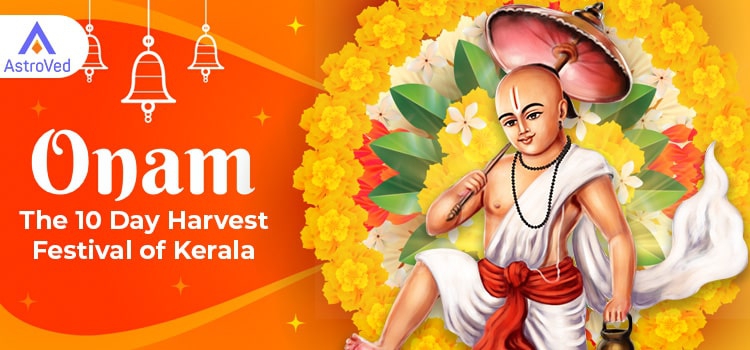Onam: The 10 Day Harvest Festival of Kerala
What is Onam?
Come Onam, and all roads lead to Kerala, where a 10-day cultural extravaganza unfolds as Malayalis get ready to celebrate the most-awaited festival of God’s own country – Onam!
Onam’s importance can be gauged from the fact that it’s the official state festival. It began as a traditional harvest festival in the month of Chingam, which marks the beginning of the Kerala New Year. The festival also celebrates the return of the legendary King Mahabali, who once ruled this part of the world. The Asura king, who was loved for his benevolence and rule of justice, is believed to return every year during Onam to see how the subjects in his erstwhile kingdom are faring. Mahabali’s reign was supposedly a golden era in the history of Kerala when there was all-round prosperity, equality, and fraternity among the people.
The Story of Mahabali
Most Asuras (demons) have a bad reputation as tyrants who wreak havoc. But Mahabali was a kind and just ruler. However, he was also powerful and wanted to extend his power over everyone, including the gods in heaven. Obviously, this didn’t go down well with the gods. So Vishnu took the avatar of Vamana, a dwarf Brahmin, to avert it. He presented himself at a Yagna that Mahabali was performing and asked for 3 paces of land. Shukracharya, the guru of the Asuras, realized that Vamana was not what he claimed to be and tried his best to dissuade Mahabali from granting his request. But Mahabali did not heed him as it would dent his image of a generous king. Vamana grew huge and covered heaven and earth with two paces. For the third, Mahabali offered his head and Vamana placed his foot on the king’s head and pushed him into the nether world.
But he also gave the king a boon whereby he could return to his kingdom on earth every year to see his beloved subjects.
During Onam, people also worship the Vamana avatar of Vishnu in temples across the state.

Onam Celebrations
Onam celebrations are spread out over the 10 days of the festival. This year -2023 – it began on August 20 and goes on till August 31.
Onam brings families and friends together. It is a time for Malayalis abroad to connect with their roots and loved ones in their homeland. Many foreigners also visit the state during this time, as it is marketed as the best time to visit the beautiful state that is so abundantly blessed by Nature. Also, they can have an immersive experience of Kerala’s culture, arts, and traditions at this time.
Let us explore the cultural feast that Onam lays out for us.
Thripunithura Athachamayam
Thripunithura Athachamayan marks the beginning of the festival. This features a street parade that includes all the folk arts of Kerala. It is a visual feast of caparisoned elephants, floats, musical ensembles, and several folk art forms. This colorful ceremony commemorates the victory of the Raja of Kochi.
Aranmula Snake Boat Race
This is one of the oldest riverboat races in India. The Aranmula Snake Boat Race takes place on the fifth day of Onam. The race takes place on the Pampa river and is witnessed by thousands of spectators, including foreigners. According to legend, Arjuna, one of the 5 Pandava brothers, came here carrying an idol of Krishna. But he could not cross the river Pampa as it was flooded. So, a passerby took him across in a makeshift boat. To honor his act of service, the boat races take place every year on the Pampa river, opposite the Krishna Temple.
Onathallu
Onathallu is a tradition where groups of people beat each other with bare hands. ‘Thallu’ means ‘fight’. The combatants hit the backs of their opponents softly. Hitting the face or landing punches and kicks are not allowed. Boys of 12 years to men aged 40 take part in it. They wear white dhotis folded up like shorts during the fight. It is a lot of fun. Onthallu tests the skill, stamina, and physical prowess of the contestants.
Pulikkali/Tiger Dance
The former Maharaja of Kochi introduced Pulikkali 200 years ago. Those who perform this dance paint their bodies to resemble tigers and dance to traditional music. They go through the streets in procession and shake their bellies to the beat of the drum, entertaining the viewers. The best place to view it is at Swaraj Round in Thrissur, Kerala.
Kaikottikali
This is a folk dance by women wearing ‘mundu neriyathu’ or Kerala’s traditional attire. Eight to ten women dance in a circle, clockwise and anticlockwise, and clap their hands. One of them sings the first line of a song, followed by a chorus. It is also called Thiruvathirakali, as it is performed on the day of Thiruvathira. The songs are based on Kathakali, the famous dance-drama form of Kerala.
Thumbi Thullal Dance
This is also a folk dance by women, who perform it during the 7th day of Onam. One woman who is the Thumbi (meaning ‘dragonfly’) sits in the center of a circle, holding a tuft comprising Thumba poo (a small plant bearing white flowers). Other women sit around her and sing folk songs. They also beat her gently with some leaves. During the climax of the song, the Thumbi begins to dance as if she is in a trance. The dance continues, and the others take turns to take on the role of Thumbi.
Onakkalikal
Onakkalikal comrprises games that allow people to display their skills and expertise. The men play Talappanthukali which is like football but is played with a ball made using many layers of dried plantain and a solid stone in between. There will be 2 teams. One protects the ball, and the other tries to grab the ball. The men also play a game similar to Kabaddi, but they utter the word ‘kutu kutu’ instead of ‘kabaddi’ to ward off the attackers.
Apart from all these, there are also floral Rangoli (Pookkalam) competitions, where contestants vie with each other to make the most intricate and beautiful rangolis using locally available flowers.
There is also the Ona Sadya, a delicious vegetarian spread of at least 25 dishes, including parippu, sambar, rasam, pulisseri, aviyal, thoran, kaalan, olan, pachadi, kaya upperi, pickle, kootu kari, inji curry, pappadam, and different types of payasam. The whole family pitches in to help the woman of the house prepare the Sadya.
The most unique thing about the Onam festival is that people of all castes and creeds celebrate it. They come together in amity and harmony to make it a grand success, to please Mahabali.




















